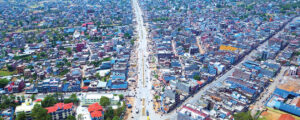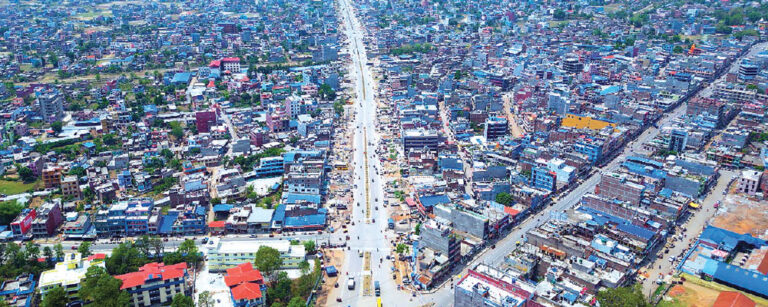Known for its rich cultural heritage and mesmerizing natural beauty, Nepal is a country that never ceases to astonish its visitors. Today, let’s venture off the beaten path and embark on an exciting journey through one of its less-explored treasures: the Rautahat district. Buckle up and prepare for a whirlwind tour!
Unfolding the Enigma: Rautahat District
Rautahat District, a hidden treasure in Nepal’s Terai belt, boasts a unique blend of cultural heritage, natural beauty, and socio-economic vibrancy. The district shares its borders with Sarlahi and Bara to the east and west, respectively, while the mighty Indian state of Bihar lies to its south. This gives Rautahat a unique position, serving as a cultural and economic bridge between Nepal and India.

Rautahat experiences a sub-tropical monsoon climate typical to the Terai region. The summers can get quite warm, reaching up to 35°C, while winters are pleasant with temperatures hovering around 10°C. The district witnesses a generous amount of rainfall during the monsoons, which paints the lush landscapes with refreshing hues of green, making it a sight to behold.
The etymology of Rautahat is quite fascinating. The term ‘Rautahat’ combines two words – ‘Raut,’ which refers to a local ethnic group, and ‘Hat,’ which translates to ‘Market.’ Thus, the name ‘Rautahat’ can be interpreted as ‘Market of the Rauts,’ suggesting its historical importance as a trade hub in the region.
Language, Ethnicity, and Lifestyle
Diversity is the spice of life in Rautahat. The district resonates with the harmonious blend of languages such as Maithili, Bhojpuri, Nepali, and Tharu, reflecting the cultural plurality of the region. It’s not uncommon to hear these languages intermingle in the bustling markets or quiet streets, adding to Rautahat’s unique charm.

The ethnic mosaic of Rautahat is equally diverse, comprising several groups like the Madhesis, Tharus, and Yadavs. Each ethnic group has its distinct customs, traditions, and festivals, creating a rich cultural tapestry that defines the district’s identity. Despite their differences, these groups coexist peacefully, united by their shared love for Rautahat and its rich heritage.
Religion plays a crucial role in Rautahat, influencing its social structure, festivals, and lifestyle. Hinduism, followed by the majority, permeates every facet of life in Rautahat, from daily rituals to grand festivals. The district is dotted with several ancient temples, with the Matsya Narayana temple in Matsari being one of the most revered.

Rautahat takes considerable pride in its above-average literacy rate, indicating a strong commitment towards education. Various schools and colleges are scattered across the district, providing quality education to its young populace. This focus on education has contributed significantly towards Rautahat’s socio-economic development, paving the way for a promising future.
Steering the Ship: Rautahat’s Administration
When it comes to governance and administration, Rautahat has established a robust system that embodies the essence of decentralized governance. The administrative machinery of Rautahat is efficiently steered from Gaur, its headquarters. Gaur, besides being the administrative hub, is also a thriving cultural and economic centre, contributing significantly to the district’s dynamism.
The district’s governance structure is neatly divided into 16 local governmental units. This intricate network of local bodies comprises both municipalities and rural municipalities, each carrying out its administrative, developmental, and governance responsibilities. Each of these units is a mini-representation of Rautahat, embodying the district’s ethos and aspirations.
The Municipalities: Pillars of Urban Governance
Rautahat is home to some prominent municipalities like Chandrapur and Gujara. Chandrapur, known for its historical and cultural significance, is a bustling urban centre with well-planned infrastructure and a host of amenities for its residents. Gujara, on the other hand, is a growing urban entity that has been making strides in terms of socio-economic development and urban planning.

Baudhimai, Brindaban, Dewahi Gonahi, Gadhimai, Garuda, Gaur, Ishanath, Katahariya, Maulapur, Madhav Narayan, Paroha, Phatuwa Bijayapur, Rajdevi, Rajpur Municipality, Durga Bhagwati and Yamunamai Rural Municipality are all the local bodies of Rautahat District.
Each of these local governmental units, be it the municipalities or the rural municipalities, contribute uniquely to Rautahat’s vibrant socio-economic tapestry. Together, they navigate the district towards a future of prosperity and growth, while preserving its rich cultural legacy.
Rautahat’s Rolodex of Attractions
Undoubtedly, Rautahat has much more to offer than just its rich cultural heritage and diverse demographics. It’s a treasure trove of tourist attractions that cater to a wide array of interests, whether you’re a history buff, a nature enthusiast, or a seeker of spiritual solace. Let’s embark on a virtual tour of the most enticing attractions that Rautahat offers to its visitors.
1. Chandrapur City: A Historic Jewel
Known for its rich history and serene ambiance, Chandrapur City is nothing short of a paradise for history enthusiasts. Once the seat of a prosperous kingdom, today, Chandrapur gracefully carries its historical legacy while keeping pace with modern development. As you traverse the city, you’ll encounter numerous monuments and sites that whisper tales of Chandrapur’s glorious past. The city’s bustling marketplaces, characterized by vibrant stalls selling everything from traditional handicrafts to delicious local delicacies, are a testament to Chandrapur’s thriving cultural fabric. Amidst the hustle and bustle, you can always find peaceful retreats in the city’s well-maintained parks and gardens.

2. Judibela: Nature’s Tranquil Retreat
Judibela is an ideal destination for those seeking an escape from the hustle and bustle of city life. Famous for being a charming picnic spot, Judibela offers a unique blend of tranquil surroundings and captivating natural beauty. Nestled amidst lush greenery, this spot offers a perfect setting for a relaxing day out with friends or family. The flowing river nearby adds to the charm of the place, creating an environment where one can truly unwind and rejuvenate. Whether you’re indulging in a picnic, taking leisurely strolls, or simply sitting back and taking in the serenity, Judibela is sure to provide a memorable experience.
3. Matsari: Where Spirituality Meets Tranquility
Matsari is renowned for its ‘Matsya Narayana’ temple, a sacred shrine that draws devotees from near and far. The temple, dedicated to Lord Vishnu’s Matsya avatar, is a symbol of the district’s rich spiritual traditions. The temple’s architecture is equally fascinating, reflecting the region’s historical and cultural influences. A visit to Matsari offers a divine experience, where spirituality meets tranquility. The annual temple festival, celebrated with much grandeur, is a sight to behold. Devotees gather in large numbers to offer prayers, making it a vibrant display of Rautahat’s religious fervor. Beyond the temple, Matsari also offers lush green landscapes and a peek into the rural lifestyle of Rautahat, making it an enticing destination for every visitor.

Whether you’re soaking up history in Chandrapur, finding solace in Judibela’s natural charm, or seeking spiritual fulfillment in Matsari, Rautahat offers experiences that leave you enriched and longing for more.
In a nutshell, Rautahat district, with its cultural richness, diverse landscapes, and warm-hearted locals, is a hidden gem that deserves a spot on every traveler’s bucket list. So, why wait? Pack your bags, and let Rautahat’s charm sweep you off your feet!
Frequently Asked Questions
The best time to visit is from October to March, when the weather is mild and pleasant.
Agriculture forms the backbone of Rautahat’s economy, with rice, wheat, and lentils being the main crops.
Rautahat is well-connected by road with major Nepalese cities, while the nearest airport is Simara Airport in Bara district.
The most commonly spoken languages are Maithili and Bhojpuri, but Nepali and Tharu are also widely understood.
Yes, there are several hotels and guesthouses available in the main cities for a comfortable stay.
More…
If you know any more places where we can visit or any other information then feel free to comment of message us.
To read about different places visit thesandeshneupane.com you can find article in Nepali language here.
Watch videos of different places on YouTube channel named as THE SANDESH NEUPANE or click here.
All the photo copyright to the respective owner. For any querry or anything related to copyright mail me with proof at sandesh@thesandeshneupane.com or admin@thesandeshneupane.com .







